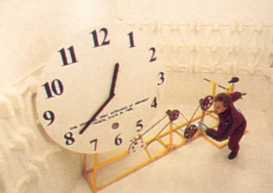The Crystal Maze Background
CRYSTAL MAZE - How the games were devised
This article is by David Bodycombe, who devised some of the games for Series 2 to 6
"While in Sixth Form of high school, I noticed that a new programme had hit the airwaves. Based on games and puzzles, the Crystal Maze had begun broadcasting in March 1990. One weekend, I set about with a pencil, a ruler, some isometric paper and a word processor and I had 20 games ideas which I submitted to the producers of the show. Two weeks later, a letter came back accepting one of the games, which was first shown on the children's special edition at the end of 1990. It consisted of nine giant cubes, each with a different coloured side on each cube. A clue was provided in that three of the cubes already had their yellow sides uppermost, so the idea of the game was to turn all 9 cubes with the yellow sides showing. By rearrangement, it was possible to read four numbers on the central intersections of the 3 x 3 grid of cubes. This provided a combination number for a lock which, once opened, gave access to the crystal.
"Much the same happened the next year, and my game for this series was The Portcullis Game. It was my all-time favorite game because the contestant had to get the crystal then play the game, which turns the normal Crystal Maze "play game, get reward" sequence on its head. The contestant enters a room and moves through a hole in the wall into an inner chamber. The crystal was on a plinth on the wall and the contestant was supposed to take it - it was amazing how many contestants ignored it and started fiddling with the other items in the room, namely some cogs on a table. Once the contestant had taken the crystal, a catch was released and a gate fell down over the hole in the wall, effectively locking the contestant into the cell. It was only at this point that the aim of the game was clear - just try and get out! By mounting the cogs onto the spindles on the table, the contestant could take a rope attached to the gate, wind it around one of the cogs, and winch the gate up, using the cog system. The producers liked this game a lot, and it was played six times during the series. A similar lock-in principle was reprised in a game (not devised by me) involving a bolted door, a series 6 game.

"I kept contributing a hanful of games for the next three years. One of my favourites was the Time Cycle game (shown), which also appeared in the introduction titles. The idea was to place a series of rubber bands between some wheels, then cycle backwards because 'the crystal only appears at midnight'. The game had a number of very close calls, including the occasional lock-in.
"Other favourite included: A game where contestants controlled a robot to pick up the crystal; another where you had to move a number of perspex overlapping disks to get several lines of 3 coloured lights; and another where contestants had to move some shutters, each one featuring one of two letters depending on how the shutter was set, to form different words. Sometimes it was unclear whether the games would work in practice, so often small models of the games were made first to test them.
"The games were devised by a variety of people. Many of the Series 1 games were devised by MENSA, the high IQ society, the remainder being devised by the production team of the show. Games in future series were also devised by former contestants of the show, television industry consultants, and Artem, the company that built the games themselves and designed the special effects. Like me, a large number of viewers (100 a year, say) also submitted ideas for games. However, most of these submissions were ideas that had already been featured, only dressed up to look different.
"The 50 games needed for each series were devised during the Summer, and built during the Autumn in time for recording the show in December each year. I worked with the director, who is responsible for the cinematic direction, and the associate producer of the programme, who is responsible for ensuring that the organisation of the programme works as it should.
"To be frank, the rewards weren't high in monetary terms - £100 per game and a credit on every show featuring one of my games. However, working on the show was an interesting experience, and it did also open a number of doors (or at least, oil the hinges) for other things I went on to do - including writing puzzle books, writing questions for other shows, and devising my own TV show formats."

